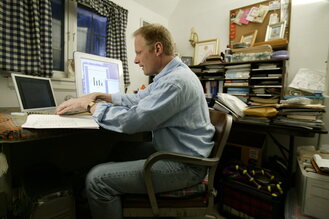|
(This is one version of the blog I wrote as the Executive Director of Research for VitalSmarts).  “Woo-hoo! I get to work from home!” Before the coronavirus, a lot of companies were hesitant to let people work from home. “Working from home” rhymes too closely with “Shirking from home.” It includes surfing, posting, grazing, running errands, crushing Candy Crush, calling your brother “just because,” rereading online stories about the coronavirus, updating your LinkedIn resume, spacing out on conference calls, and telling your boss, “I’m still waiting for Bob to get it to me so I can work on it.” But what if working from home looked different? What if working from home made you 13% more productive, made you feel more satisfied with your job, and made you half as likely to quit? This is exactly what was found in a 2015 Stanford study of a large Chinese travel firm called CTrip. Researchers randomly split 249 call center employees from Shanghai into two groups. For nine months, half of them kept working at their desks as usual, and the other half were told to work from home four days a week (one day a week they came into the office). Then the researchers measured everything from the number of calls they made, to job satisfaction, to breaks taken, to sick days… everything but Facebook Likes and Candy Crush scores. One conclusion: Working from home can make people more productive. But wait. Before you try to sell the conference table on eBay, there’s a huge caveat from this study (aside from country and culture): These workers had very specific measures of productivity—phone calls per minute and the amount of time spent on the phone. Whereas those in customer service, copywriting, or design might have very specific measures of productivity (dollars, calls, pages, or projects), other workers might have to deal with more collaboration and face-to-face meetings. For them, working at home can be challenging. It requires accountability, better work habits, and a general ability to get things done when there are roaring distractions all around. Since working at home requires a discipline muscle that many of us need to strengthen, it’s easy to let our first days or weeks at home be structured by meetings and not our mission. That is, we might view the phone or web meetings on our calendar as the “Big rocks” of our day instead of seeing our biggest projects as our biggest rocks. After you conduct a weekly review of the projects that are most pressing, these suggestions might help. • Identify the three biggest project tasks you need to complete each day (not including meetings). • Make a promise to complete these tasks and deliver results to another person (boss or coworker). • Check in for a follow-up after making the delivery. This is the productivity side of working at home. But there’s another side to working at home that has been widely ignored. It’s the human side. There’s a story of three people who find themselves stranded on an uncharted desert island. Sort of like Gilligan’s Island, but without commercials. After years of learning how to smoothly work together to survive, the trio one day finds a bottle with a genie in it. The genie grants each person a wish. The first wishes to be back home in California, and—poof—she’s gone. The second wishes to be reunited with his family in Texas, and—poof—he’s gone. The third person looks around the empty island and says to the genie, “You know, I miss my two friends. I wish they were back.” Here’s the rest of the story about the Chinese workers. After nine months of working at home, the study was over. The workers were told they could continue working from home four days a week or they could come back and grind it out in-office for the full five. Slightly more than half of these workers wanted to come back and work in the office. They reported they were too “lonely.” There’s a human side to working at home. We can use VitalSmarts tools to strengthen our communication muscle and our productivity muscle, but we might still feel like something is missing. Leaning in (versus spacing out) during meetings might help, and checking in or following up after finishing a project piece might help. But this human solution will need some personal thought and personal tailoring for each of us. If we’re feeling restless after 4 days at home, the human side is where we might want to look. And maybe call your brother “just because.” Comments are closed.
|
Welcome!Here are some tips, tricks, and secrets on how you and your family can eat to be healthier and happier. They're based on over 30 years of our published research.
Fun InterviewsMost Visited Last Month• For You
• Smarter Lunchrooms • The X'Plozionz Band • Help your family • Kitchen Scorecard • Retracted papers • Grocery secrets • Do kids inherit taste? • Be healthier at work • How not to retire • Estimating calories • Restaurant Secrets • Syllabus template Top 2024 Downloads• Kitchen Makeover
• Smarter Lunchrooms • Smarter Lunchroom Scorecard • Grocery Shopping Hacks • Restaurant Secrets • Write a Useful Syllabus • Workplace Wellness Tips • Healthy Profitable Menus Categories
All
|




 RSS Feed
RSS Feed